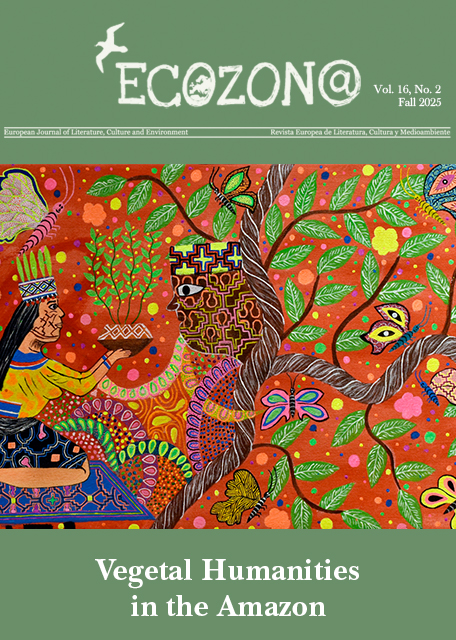<b>On the Death of Plants: John Kinsella’s Radical Pastoralism and the Weight of Botanical Melancholia</b> // Sobre la muerte de las plantas: El pastoreo radical de John Kinsella y el peso de la melancolía botánica
DOI:
https://doi.org/10.37536/ECOZONA.2016.7.2.1004Palabras clave:
Australian poetry, John Kinsella, critical plant studies, radical pastoralism // Poesía australiana, estudios críticos de la planta, pastoreo radicalResumen
Through the poetry of Australian writer and activist John Kinsella (b. 1963), this article emphasizes the actual, embodied—rather than metaphorical—dimensions of the death of plants vis-à-vis the pressing international context of accelerating botanical diversity loss (Hopper) and the anthropogenic disruption of floristic communities globally (Pandolfi and Lovelock). On many levels—scientific, ecological, social, metaphysical—a fuller appreciation of plant life necessitates an understanding of their decline, decay, and demise. Toward a more nuanced appreciation of plant lives, the discussion draws a distinction—but aims to avoid a binary— between biogenic and anthropogenic instances of plant-death. Considering the correlation between vegetal existence, human well-being, and our co-constituted lives and deaths, I assert that a more encompassing and ecoculturally transformative outlook on plants involves not only an acknowledgement of their qualities of percipient aliveness but also a recognition of their senescence and perishing. Kinsella’s poetry reflects such themes. His botanical melancholia derives from the gravely fragmented locus of his ecological consciousness: the ancient, native plantscape existing as small, disconnected remnants within the agro-pastoral wheatbelt district of Western Australia. Consequently, rather than an incidental occurrence, plant-death is essential to Kinsella’s enunciation of radical pastoralism as a counterweight to an idyllic textualization of botanical nature as existing in an unimpacted Arcadian state of harmony, balance, and equitable exchange with the built environment (Kinsella Disclosed 1–46).
Resumen
A través de la poesía del escritor y activista australiano John Kinsella (1963), este artículo hace hincapié en las dimensiones reales, en vez de metafóricas, de la muerte de las plantas frente al apremiante contexto internacional de acelerar la pérdida de diversidad botánica (Hopper) y la alteración antropogénica de las comunidades florísticas a nivel mundial (Pandolfi y Lovelock). En muchos niveles, científico, ecológico, social-metafísico, una apreciación más completa de la vida vegetal requiere una comprensión de su declive, decadencia y desaparición. Hacia una apreciación más matizada de las vidas de las planta, el debate suscita una distinción, pero tiene como objetivo evitar un dualismo, entre ejemplos biogénicos y antropogénicos de muertes de plantas. Teniendo en cuenta la correlación entre la existencia vegetal, el bienestar humano, y nuestras vidas y muertes co-constituidas, afirmo que una perspectiva más abarcadora y transformadora eco-culturalmente sobre las plantas implica no sólo un reconocimiento de sus cualidades de vitalidad perspicaz sino también un reconocimiento de su senectud y ruina. La poesía de Kinsella refleja este tipo de temas. Su melancolía botánica deriva del locus seriamente fragmentado de su conciencia ecológica: el paisajismo vegetal antiguo y nativo que existe como restos pequeños, desconectados dentro del distrito agropastoral del cinturón-de-trigo de Australia Occidental. En consecuencia, en lugar de un mínimo hecho en su obra, la muerte de la planta es esencial para la enunciación de Kinsella del pastoreo radical australiano. Su poesía proporciona un como un contrapeso a una textualización idílica de la naturaleza botánica que existe en un estado arcádico e inmaculado de armonía, equilibrio, e intercambio equitativo con el entorno construido (Kinsella, Disclosed 1–46).
Descargas
Descargas
Publicado
Número
Sección
Licencia
Authors who publish with this journal agree to the following terms:
a) Authors retain copyright and grant the journal right of first publication with the work simultaneously licensed under a Creative Commons Attribution License that allows others to share the work with an acknowledgement of the work's authorship and initial publication in this journal (CC BY-NC for articles and CC BY-NC-ND for creative work, unless author requests otherwise.
b) Authors are able to enter into separate, additional contractual arrangements for the non-exclusive distribution of the journal's published version of the work (e.g., post it to an institutional repository or publish it in a book), with an acknowledgement of its initial publication in this journal.
c) Authors are permitted and encouraged to post their work online (e.g., in institutional repositories or on their website) prior to and during the submission process, as it can lead to productive exchanges, as well as earlier and greater citation of published work (See The Effect of Open Access).










